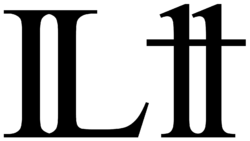Digraph (orthography)
A digraph (from the Greek: δίς, dís, 'double' and γράφω, gráphō, 'write'), also known as a bigraph, digram or bigram, is a string of two letters where the number of written characters does not match the number of sounds that are spoken. In other words, two letters are used to represent one phoneme (distinct sound). For example, since there are no single letters in English alphabet to represent the sounds /ʃ/, /tʃ/, and /θ/, English uses a string of two letters to represent the sounds in the same order sh, ch, and th. While other sounds such as /f/ and /ʍ/ already have letters that correspond to the sounds, f and hw, digraphs ph and wh are used in some words to show their etymologies (origins of words) rather than their current pronunciation.
List of English digraphs
List of Cyrillic digraphs
- Ғә corresponds /ʁʷ/ or /ɣʷ/.
Digraph (orthography) Media
digraph
 ll]] fused for a time into a ligature.
ll]] fused for a time into a ligature.
Related pages
- Trigraph, a similar string of three letters
